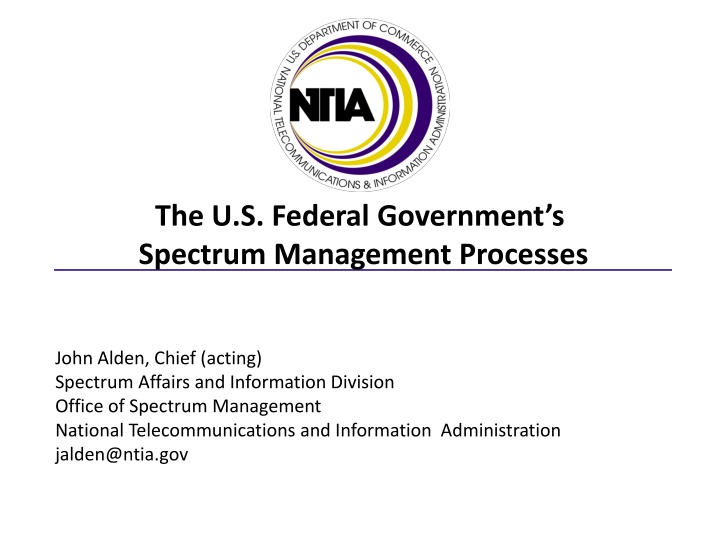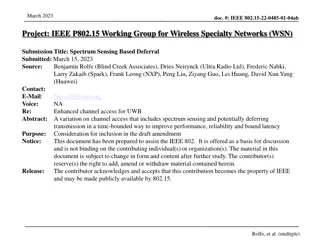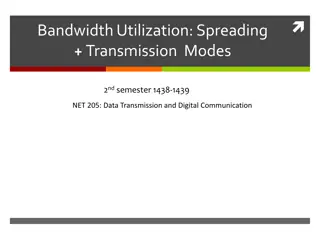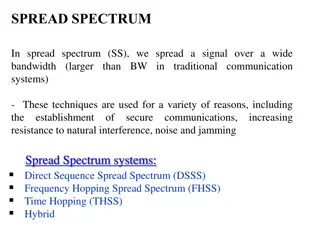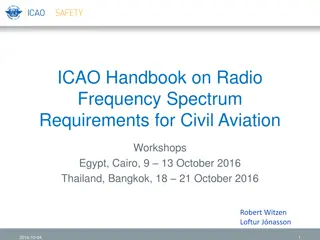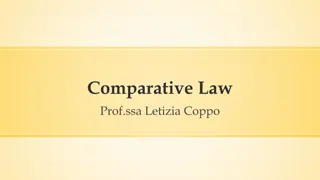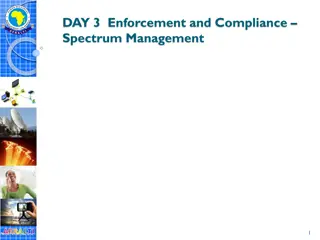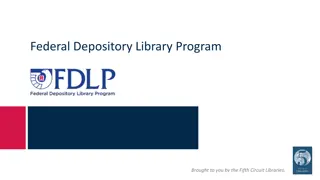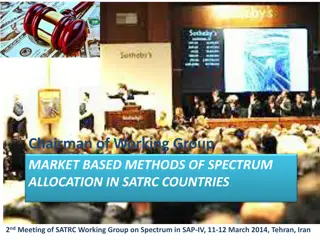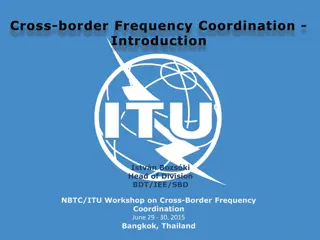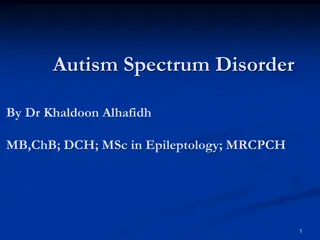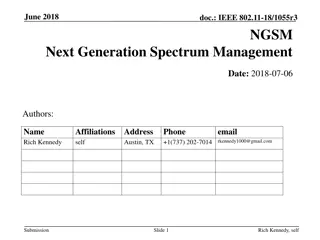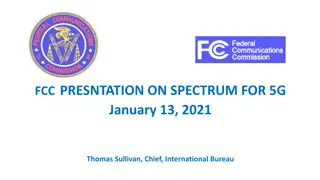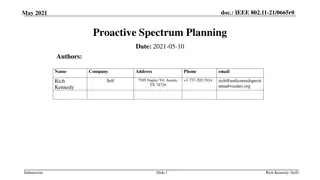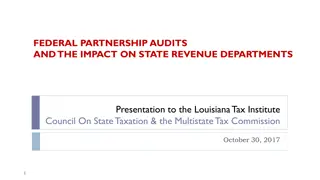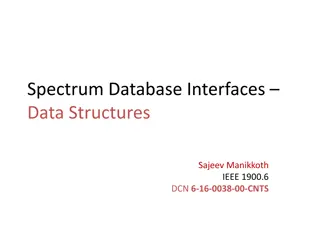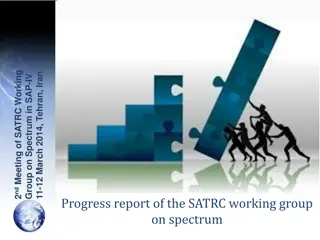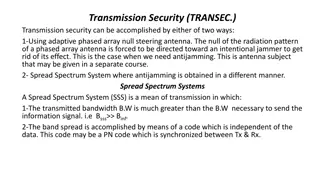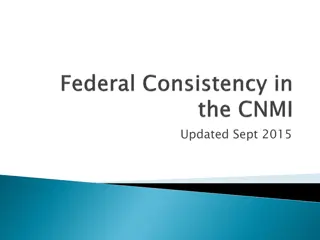U.S. Federal Spectrum Management Overview
This content provides a detailed insight into the U.S. Federal Government's spectrum management processes, covering topics such as basic concepts, spectrum allocation, regulatory frameworks, policy setting, and the roles of key agencies like the FCC and NTIA. It delves into the fundamental elements of spectrum management, the legal and regulatory frameworks, and the coordination with international entities. The U.S. spectrum management framework, including key acts and coordination mechanisms, is also outlined.
Download Presentation

Please find below an Image/Link to download the presentation.
The content on the website is provided AS IS for your information and personal use only. It may not be sold, licensed, or shared on other websites without obtaining consent from the author.If you encounter any issues during the download, it is possible that the publisher has removed the file from their server.
You are allowed to download the files provided on this website for personal or commercial use, subject to the condition that they are used lawfully. All files are the property of their respective owners.
The content on the website is provided AS IS for your information and personal use only. It may not be sold, licensed, or shared on other websites without obtaining consent from the author.
E N D
Presentation Transcript
The U.S. Federal Governments Spectrum Management Processes John Alden, Chief (acting) Spectrum Affairs and Information Division Office of Spectrum Management National Telecommunications and Information Administration jalden@ntia.gov
Topics To Be Covered Review: Basic Concepts & Functions of Spectrum Management The U.S. Approach to Spectrum Management Overview of Federal Spectrum Uses How the Federal Government Manages Its Spectrum Use Legal framework Regulatory framework Who Carries Out Key Functions of Federal Spectrum Management Coordination with Other Spectrum Managers & Policymakers National: the Federal Communications Commission International: CITEL and ITU U.S. Department of Commerce National Telecommunications and Information Administration 2
Policy, Regulation & Management Policy = High-level government goals and objectives. Policy is set & articulated by Congress, the President and the Courts. Regulation = Rules that are applied to achieve policy goals. Regulators develop rules and apply them to market players or stakeholders. Regulations are expressed through legal or regulatory codes, with enforcement regimes. Management = Expert-level administration of standard processes needed to implement policy and regulatory decisions. Examples include equipment certification, frequency assignment, coordination of satellite operations. All three are developed through public input, informed by multiple interests & constituencies, and (should be) applied by experts. Spectrum use is recognized as a legitimate area for policy, regulation & management. U.S. Department of Commerce National Telecommunications and Information Administration 3
Spectrum Management Elements There are several basic elements of spectrum management & regulation: Planning Allocation Assignment Setting rules/regulations Monitoring Enforcement In the U.S., there are two agencies that divide and coordinate spectrum management roles and duties: The Federal Communications Commission (FCC) and the Department of Commerce s National Telecommunications and Information Administration (NTIA U.S. Department of Commerce National Telecommunications and Information Administration 4
U.S. Spectrum Management Framework Communications Act of 1934+ The President Congress NTIA Organization Act+ NTIA FCC Domestic and International Coordination 47 CFR Part 300 FCC Chair + NTIA A/S bi-annual meeting FCC Rules 47 CFR Parts 0-199 Non-Federal Users Federal Users Interdepartment Radio Advisory Committee Chaired by NTIA OSM 19 Federal agency members NTIA Manual Advisory Liaison Interagency Spectrum Advisory Council (ISAC) Chaired by NTIA Assistant Secretary Federal agencies + FCC and White House Commerce Spectrum Management Advisory Committee Non-government advisors to Department of Commerce/NTIA Technological Advisory Council Non-government advisors to FCC U.S. Department of Commerce National Telecommunications and Information Administration 5
Overview of Federal Spectrum Uses National defense Law enforcement and public safety Air traffic control Space exploration and science Weather and earth science Resource management & recreation Just to name a few . U.S. Department of Commerce National Telecommunications and Information Administration 6
Scale & Scope of Federal Usage The U.S. Federal government is among the most diverse & sophisticated users of spectrum in the world. In CY 2022, there were 85,222 requests for frequency assignment actions, plus an additional 1,624 requests for Special Temporary Authority. This covers space-based, aeronautical, maritime and terrestrial domains. Includes radars, satellites, sensors, communications the mast majority of ITU- defined services. U.S. Department of Commerce National Telecommunications and Information Administration 7
How the Federal Government Manages Its Own Spectrum Legal Authority: The Communications Act of 1934, Section 305, reserves to the U.S. President the authority to regulate spectrum used by government stations. Presidential authority has been delegated to NTIA through a series of executive actions. President Nixon created the Office of Telecommunications Policy in 1970. President Carter created NTIA in the Dept. of Commerce in 1978. The NTIA Organization Act, passed by Congress in 1992, codified NTIA s statutory role as manager of the Federal Government s spectrum use. U.S. Department of Commerce National Telecommunications and Information Administration 8
NTIA's Principal Responsibilities and Functions Serving as the principal executive branch adviser to the President on telecommunications and information policy; Prescribing policies for and managing Federal use of the radio frequency spectrum; Developing and presenting U.S. plans and policies at international communications conferences and related meetings; Serving as the principal Federal telecommunications research and engineering laboratory, through NTIA's Institute for Telecommunication Sciences (ITS), headquartered in Boulder, CO. U.S. Department of Commerce National Telecommunications and Information Administration 9
NTIAs Spectrum Regulatory Structure NTIA s spectrum management activities are carried out by two offices: The Office of Spectrum Management (OSM) The Institute for Telecommunication Sciences (ITS) NTIA works through an inter-agency group representing major federal users: The Inter-Department Radio Advisory Committee or IRAC. Federal spectrum rules are published in the NTIA Manual or Red Book U.S. Department of Commerce National Telecommunications and Information Administration 10
Office of Spectrum Management Manages all federal government use of the radio spectrum Develops policy & regulations governing spectrum use by federal agencies and departments Supports national spectrum policy priorities, initiatives, and programs Meeting the increasing spectrum needs of the United States while balancing the national security and economic interests of our nation U.S. Department of Commerce National Telecommunications and Information Administration 11
Office of Spectrum Management Associate Administrator Charles Cooper Deputy Associate Administrator for Spectrum Management Vacant Deputy Associate Administrator for Spectrum Planning and Policy Derek Khlopin Executive Director Scott Patrick Spectrum Engineering and Analysis Division Ed Drocella Spectrum Affairs and Information Division John Alden IRAC Spectrum Services Division Binyam Tadesse Strategic Planning Division Byron Barker International Spectrum Policy Division Charles Glass Secretariat Division Alan Frable Deputy, Chair Frequency Assignment Subcommittee Deputy, Chair Spectrum Planning Subcommittee Spectrum Engineering Branch Satellite Branch Terrestrial Branch Frequency Assignment Branch Spectrum Analysis Branch Systems Review Branch U.S. Department of Commerce National Telecommunications and Information Administration 12
IRAC Members* Chair (NTIA) Air Force StateEnergy U.S. Postal Service NASA VA DHS Navy FCC BBG Treasury (Liaison) Agriculture FAA Interior NSF Justice Commerce Coast Guard Army Transportation * Observers: Defense (DISA), NSA and FDA 18
IRAC Subcommittees Emergency Planning Subcommittee (EPS) Reviews National Security and Emergency Preparedness (NSEP) planning for spectrum-dependent systems. Frequency Assignment Subcommittee (FAS) Assignment and coordination of radio frequencies. Radio Conference Subcommittee (RCS) Preparing for CITEL and ITU conferences and meetings. Space Systems Subcommittee (SSS) International registration of federal government satellite systems with the ITU. Spectrum Planning Subcommittee (SPS) Apportionment of spectrum space for the support of established or anticipated radio services and among federal users. Technical Subcommittee (TSC) Addressing issues that relate to the technical aspects of the use of the electromagnetic spectrum, such as technical standards, propagation, EMC, etc. Ad Hoc groups (task groups) U.S. Department of Commerce National Telecommunications and Information Administration 14
NTIA Manual or Red Book Manual of Regulations and Procedures for Federal Radio Frequency Management (Red Book) Incorporated by reference into Code of Federal Regulations Specifically, 47 CFR, Section 300.1 Federal agencies must comply with the Manual when requesting or using radio frequency spectrum 11 Chapters and 15 Annexes Proposed changes are discussed in the IRAC with final approval by NTIA U.S. Department of Commerce National Telecommunications and Information Administration 15
NTIA Manual Contents 1. 2. 3. 4. 5. 6. 7. 8. 9. 10. Procedures for the Review of Telecommunications Systems 11. Public Access to the Federal Spectrum Management Process Authority and Organization Telecommunication Policy International Matters Allocations, Allotments and Plans Spectrum Standards Definitions and Particulars of Assignments Authorized Frequency Usage Procedures and Principles for the Assignment and Coordination of Frequencies Preparation of Applications for Frequency Assignment Action Plus 15 Annexes U.S. Department of Commerce National Telecommunications and Information Administration 16
Coordination with Other Regulators National Coordination FCC coordination: MOU, meetings, preliminary view of draft decisions on some matters Executive Branch: PPSG and WH/OMB International Coordination: ITU-R Study Groups and Working Parties World Radiocommunication Conference prep CITEL The Inter-American Telecommunications Commission (PCC.II) U.S. Department of Commerce National Telecommunications and Information Administration 17
Summary & Conclusions Different countries have evolved varying ways to manage spectrum resources. The U.S. has a uniquely large government sector with advanced wireless systems. Government spectrum use can foster technology innovation and dual-use technologies. Coordination among all policymakers and regulators is vital to optimize spectrum use. U.S. Department of Commerce National Telecommunications and Information Administration 18
